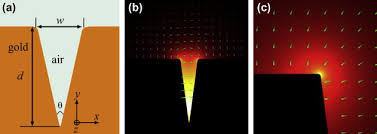https://www.youtube.com/watch?v=_jV_XVgMRiAMining diamonds with LION
There are a number of indications that can be found in the LION experiments that LENR produced magnetic flux tubes can both transport and transmit matter: see the video above. This matter is most likely stored as single unpaired quarks mated to a magnetic flux line of a LENR flux tube.
At 15:17 of the video, Bob describes the charge cluster. I understand this surface based EMF vortex formation mechanism to be Surface Plasmon Polariton (SPP) generation where infrared photons and electrons become entangled quantum mechanically. This entanglement mechanism transforms electrons into bosons. Electrons can now form a Bose condensate. This electron transformation process is the first or base line step in the vortex formation process. This vortex of photon/electron spin currents have long been studied by nanoplasmonic.

An SPP can form inside cavities or on protrusions on the surface of most metals.
At 20:50 of the video, Bob introduces the wonderful innovation that LION has come up with to produce ultra dense deuterium. Just like what happens in palladium, diamond absorbs deuterium from its surface in a fuel preparation process and the crystal structure of the diamond lattice gradually compresses the deuterium into a super dense form(as per Holmlid).
At 28:40 of the video, Bob describes the production of electrons as one of the energy output formats of the LENR reaction. The ultra dense deuterium using SPPs carried on its surface will breakdown matter into sub atomic particles which are mostly mesons and after a decay process, those mesons convert to electrons.
At 37:07 of the video, Bob describes the tracks made by a monopole vortex, probably a ultra dense deuterium molecule that has been converted from the dipole form to the monopole state via the KERR effect. This molecule seems to spin around as it moves over the surface and wherever its open flux tube hits matter, that flux tube excavates a hole in the matter. The quarks from that matter are removed from there natural partners and remain connected to the open flux tube through a process of flux tube re-connection. These decoupled quarks are now carried along via the ultra dense molecule as it travels along.
The SPP need a host to move. The Ultra dense deutrium provides that host as an almost perfect partner.
At 39:23 in the video, Bob describes the tracks produced by the dipole based ultra dense deuterium molecule or else a Bose condensate of SPPs. The ultra dense deuterium molecule can carry the Bose condensate of SPPs on its surface. A nanowire will aways form a Bose condensate of SPPs on its surface. Such nanowires can also be LENR active with the SPP cover serving as the active LENR agent.
At 42:37 in the video, Bob describes the detailed nature of the vortex flux tube that the SPP Bose condensate is producing. This condensate is made up of two counter-rotating currents of electron/photon AKA SPP spin. There is a right handed current and a left handed current rotating in the Bose condensate. This type of condensate is called a petal condensate. Energy is stored in the spin currents and also the dipoles of the electron–hole pair that support the spins. The electron–hole pair stays put and oscillate but the associated spin currents can move around. The Spp has three possible modes: monopole, dipole and quadrupole.
The SPP flux tube spins synchronous with the spin current, it is chiral, and can vary widely in energy content. The two spin currents are comprised of a right handed SPP spin current and a counter rotating left handed SPP spin current. These characteristics are essential in order it made this flux tube structure compatible with the inter-quark flux tube structure.
At 44:29 in the video, Bob describes the changes in the surface of the ECCO reactors plastic fuel container. The flux tubes associated with the LENR vortexes removes plastic in layers based on the intensity of the magnetic flux lines of the vortex.
In ECCO, it looks like the dipole mode of the vortex is stationary but the monopole mode is mobile. Such monopole rotation might be related to angular momentum. For example, a duel counter-rotating helicopter blade will maintain a stable platform, but a single rotating blade will cause the platform to spin as a counter reaction to the momentum of the blade.
I like to explicitly state the obvious. This LION experiment places very tight constraints on the nature of the vortex that supports the LENR characteristics that are being observed. Not any old plasmoid can produce these LENR characteristics.
The monopole vortex will both spin and move forward being propelled by the opposing momentum of a single spin current.
At 48:14 of the video, Bob comments on the John Hutchison example where there is no Ultra dense material to host the SPP condensate, but the condensate still shows it characteristic flux tube based nature.
At 51:21 of the video, The SPP vortex has removed copper from the plate and has transmuted that copper into a magnetic metal.
At 52:00 of the video, Bob brings out a John Hutchison experimental metal fragment.
In my opinion, cold electricity is the production of electrons from the transformation of protons and neutrons first into mesons, and then into electrons through a meson decay process.







